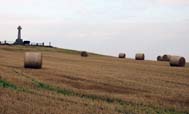…Cuthbert of Farne.
Cuthbert became prior of Lindisfarne in 664, but decided to move to a quieter life of solitude on the island of Inner Farne:
Lindisfarne Priory on Holy Island is one of the most important early centres of Christianity in Anglo-Saxon England. Founded in 635 and home to a small number of monks, it was to become a shrine when the body of Cuthbert was exhumed 11 years after his burial and found undecayed. Cuthbert was an exceedingly Holy man who became the prior of Lindisfarne in 664 but left for a life of solitude on the island of Inner Farne. He became bishop of Lindisfarne in 685. Fleeing from the Viking raids, the community of monks left Lindisfarne with the body of Cuthbert in 875, re-establishing St Cuthbert’s shrine at Chester-le-street and then in Durham in 995.
Fenwick Lawson’s original sculpture, ‘Cuthbert of Farne’ was carved from an elm tree in 1983 and stood in the cloisters of Durham Cathedral where it was seen by many millions of visitors. In 1999, the Northern Rock Foundation commissioned the artist to cast Cuthbert of Farne in bronze. This sculpture depicts a contemplative Cuthbert, reflecting his religious life and desire for solitude. His interlaced hands echo the stillness and peace he sought, whilst an eider duck broods in sanctuary at his feet. Lindisfarne itself is also portrayed, with echoes of the many rugged elements of the island on which he lived.*
More C inspiration can be found in the gallery.
*From English Heritage guidebook 2002 and promotional leaflets 2013.











It’s hard to even imagine dates in three digits!
Even harder to imagine the minus ones
Really powerful image and I love the story behind the sculptor. Thanks so much for sharing.
I am glad you enjoyed it
Did you see their Gospels?
The replica one, of course.
London keeps the best stuff in town.
The actual gospels were on display at Durham when I visited. They were on loan for a short period. Unfortunately I didn’t get to see them, I would have meant waiting too long in Durham.
Great history lesson and also something I’ve learned. I remember the sculpture in the middle of Durham Cathedral Cloisters for years but was too far from view to appreciate what it was. I never asked what it was as it was an intrusion on the artistic shots of the cloister that I was trying to take. Thanks for this post, you’ve answered a historic question for me & given me some other detail that I never managed to see.
I am glad that you learned something new from my post I am always learning things on my visits and holidays
I am always learning things on my visits and holidays 